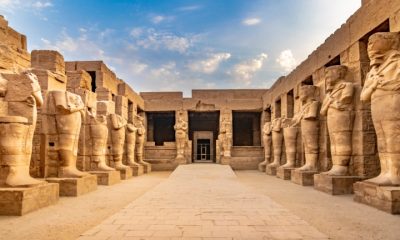
Shutterstock
For history lovers, the world is full of incredible destinations where the past comes to life. From ancient ruins to historic cities, these places offer a chance to explore the stories and cultures that have shaped human history. Whether you’re drawn to grand monuments, old castles, or fascinating museums, there’s something for everyone who enjoys diving into the past.
Each location reveals unique moments in time, giving visitors a deeper understanding of how the world once was. If you’re ready to explore history firsthand, these destinations will take you on an unforgettable journey through time.
Rome, Italy

Shutterstock
Rome, often called “The Eternal City,” is one of the most historically rich destinations in the world. The city offers iconic sites such as the Colosseum, where gladiators once fought, and the Roman Forum, the center of political life in ancient Rome. Visitors can also marvel at the Pantheon, a well-preserved Roman temple, and explore the treasures of Vatican City, including St. Peter’s Basilica and the Sistine Chapel. From ancient ruins to Renaissance art, Rome is a living museum that spans thousands of years of history.
Athens, Greece

Shutterstock
Athens is the birthplace of democracy and a city where the ancient and modern worlds blend seamlessly. The Acropolis, with its majestic Parthenon, is a testament to the architectural prowess of ancient Greece. The Ancient Agora, once a marketplace and public square, offers insight into the city’s political and social life. Beyond the ruins, Athens’ museums, including the National Archaeological Museum, display an astonishing collection of Greek artifacts, making it a paradise for history lovers.
Cairo, Egypt

Shutterstock
Cairo is a city that connects visitors with the grandeur of ancient Egypt, home to some of the most famous monuments in the world. The Pyramids of Giza, including the Great Pyramid and the enigmatic Sphinx, are awe-inspiring feats of engineering and an enduring symbol of Egyptian civilization. The Egyptian Museum in Cairo houses over 120,000 artifacts, including treasures from the tomb of Tutankhamun. Beyond its ancient wonders, Cairo is also a vibrant modern city with a rich Islamic heritage.
Kyoto, Japan

Shutterstock
Kyoto, once the capital of Japan for over a millennium, is a city filled with stunning temples, palaces, and traditional wooden homes. Visitors can explore the famous Golden Pavilion, Kinkaku-ji, and experience the peace of the Fushimi Inari Shrine, known for its thousands of vermilion torii gates. Kyoto is also renowned for preserving traditional Japanese arts, including tea ceremonies and geisha culture. This serene city offers a unique glimpse into Japan’s imperial past, where every corner reflects centuries of history.
Machu Picchu, Peru

Shutterstock
Machu Picchu, the famed “Lost City of the Incas,” is one of the most extraordinary archaeological sites in the world. Nestled high in the Andes Mountains, this ancient city was hidden from the world until its rediscovery in 1911. The ruins, including temples, palaces, and agricultural terraces, reveal the sophistication of Incan engineering and society. A visit to Machu Picchu not only offers breathtaking views but also a deep connection to the history and spirituality of pre-Columbian civilizations.
Jerusalem, Israel

Shutterstock
Jerusalem is a city of immense religious and historical significance, sacred to Jews, Christians, and Muslims alike. The Old City is divided into quarters, each offering a glimpse into its complex history, from the Western Wall to the Dome of the Rock and the Church of the Holy Sepulchre. Visitors can walk along ancient streets that have witnessed millennia of human history, war, and worship. Jerusalem’s role as a spiritual and political center ensures its place as a must-visit for history buffs.
Istanbul, Turkey

Shutterstock
Istanbul, straddling the continents of Europe and Asia, is a city where East meets West in a fascinating blend of cultures and history. Formerly known as Constantinople, it was the capital of both the Byzantine and Ottoman empires, leaving behind an architectural legacy that includes the Hagia Sophia, Topkapi Palace, and the Blue Mosque. The city’s strategic location made it a crossroads of trade, culture, and religion for centuries. Today, Istanbul’s bustling bazaars and stunning landmarks offer visitors a rich journey through the ages.
Paris, France

Shutterstock
Paris is a city that has played a central role in European history, from the French Revolution to the Enlightenment. Iconic sites like the Palace of Versailles and Notre-Dame Cathedral reflect its royal and religious past, while the Louvre Museum houses thousands of years of art and history. The streets of Paris are lined with monuments and historical cafés where intellectuals, artists, and revolutionaries once gathered. Whether wandering along the Seine or visiting the historic Marais district, Paris offers a deep dive into the cultural and political history of Europe.
Beijing, China

Shutterstock
Beijing, the heart of China for centuries, is a city rich in imperial history and modern transformation. The Forbidden City, a sprawling palace complex, once housed Chinese emperors and remains a symbol of the country’s dynastic past. Other historical landmarks include the Great Wall of China, one of the most famous defensive structures in history, and the Temple of Heaven, where emperors prayed for good harvests. Beijing’s combination of ancient sites and its role in shaping modern China makes it a fascinating destination for history lovers.
Mexico City, Mexico

Shutterstock
Mexico City is a city of contrasts, built on the ruins of the ancient Aztec capital of Tenochtitlán and infused with Spanish colonial influence. Visitors can explore the Templo Mayor, the remains of the Aztec temple complex, and travel to nearby Teotihuacán, home to the Pyramid of the Sun and Moon. Colonial-era landmarks such as the Metropolitan Cathedral stand alongside modern structures, highlighting the city’s layered history. Mexico City’s museums, particularly the National Museum of Anthropology, offer insights into the country’s pre-Columbian and colonial past.
Petra, Jordan

Shutterstock
Petra, often called the “Rose City” due to the pink hue of its sandstone cliffs, is one of the most stunning archaeological sites in the world. Carved by the Nabataeans, Petra was once a bustling trading city connecting East and West. Visitors enter through the narrow Siq canyon, eventually emerging to the sight of the magnificent Treasury, Petra’s most iconic structure. Exploring Petra’s tombs, temples, and amphitheaters is like walking through a lost world, preserved in the rock.
Berlin, Germany

Shutterstock
Berlin is a city deeply intertwined with the events of the 20th century, making it a vital destination for modern history buffs. The remnants of the Berlin Wall, Checkpoint Charlie, and the Brandenburg Gate serve as reminders of the Cold War and Germany’s division. The city’s Holocaust Memorial is a somber tribute to the atrocities of World War II, while museums like the Pergamon showcase ancient civilizations. Berlin’s dynamic history of conflict, division, and reunification is palpable in its streets, making it a compelling destination for historical exploration.
Angkor, Cambodia

Shutterstock
Angkor, once the capital of the Khmer Empire, is home to one of the largest and most awe-inspiring temple complexes in the world. Angkor Wat, the crown jewel, is a marvel of architecture and artistry, representing the height of Khmer culture and religious devotion. The ancient city of Angkor Thom, with its Bayon Temple, is adorned with giant stone faces that watch over the jungle. Exploring Angkor offers a journey into Southeast Asian history and a glimpse of a once-mighty empire that shaped the region.
Florence, Italy

Shutterstock
Florence is the birthplace of the Renaissance, a period of extraordinary cultural and intellectual achievement in Europe. The city is home to iconic landmarks like the Florence Cathedral, with its massive dome engineered by Brunelleschi, and the Uffizi Gallery, which houses masterpieces from artists like Leonardo da Vinci and Michelangelo. Florence’s streets are filled with historical significance, as the city was once ruled by the powerful Medici family. A visit to Florence immerses you in the art, architecture, and history that defined the Renaissance.
Delhi, India

Shutterstock
Delhi, the capital of India, offers a fascinating mix of ancient and modern history, having served as the seat of power for numerous empires. The imposing Red Fort and Humayun’s Tomb reflect the grandeur of the Mughal Empire, while Qutub Minar, a towering minaret, showcases Delhi’s medieval history. British colonial influence is evident in landmarks like India Gate and Rashtrapati Bhavan. Delhi’s rich past, combined with its vibrant present, makes it an essential destination for those interested in South Asian history.
St. Petersburg, Russia

Shutterstock
St. Petersburg is Russia’s imperial capital, renowned for its grandeur and cultural legacy. Founded by Peter the Great, the city boasts architectural marvels like the Winter Palace, home to the Hermitage Museum, which contains a vast collection of art and artifacts. The Peter and Paul Fortress offers insight into the city’s military history, while the ornate Church of the Savior on Spilled Blood reflects its religious significance. St. Petersburg’s blend of history, art, and culture makes it a captivating destination for history enthusiasts.
Cusco, Peru

Shutterstock
Cusco, once the capital of the Inca Empire, is a city where ancient Incan history and Spanish colonial heritage converge. Visitors can explore Incan sites like Sacsayhuamán, a fortress with intricately crafted stone walls, and the Qorikancha, a former Incan temple now overlaid with a colonial church. Cusco’s well-preserved streets and architecture tell the story of the Inca civilization’s rise and fall. The city serves as the gateway to Machu Picchu, offering a broader understanding of the region’s historical significance.
Vienna, Austria

Shutterstock
Vienna, once the heart of the Austro-Hungarian Empire, is a city where imperial history and cultural achievement come to life. The grandeur of Schönbrunn Palace and the Hofburg reflect the opulence of the Habsburg dynasty. Vienna was also a center for classical music, philosophy, and art, with figures like Mozart, Beethoven, and Freud leaving their mark on the city. Visitors can explore its museums, concert halls, and palaces to experience the splendor of imperial Europe.
Moscow, Russia

Shutterstock
Moscow, Russia’s capital, has been at the center of the country’s political and cultural life for centuries. The Kremlin, a historic fortress complex, and Red Square, home to the iconic St. Basil’s Cathedral, are symbols of Russian power and influence. The city’s history stretches from the era of the tsars to the Soviet Union and modern Russia, making it a crucial destination for understanding the country’s past. Moscow’s museums and historical landmarks provide deep insight into the forces that have shaped Russia’s history.
Seville, Spain

Shutterstock
Seville is a city that reflects Spain’s Moorish past and Christian reconquest in its stunning architecture and cultural heritage. The Alcázar of Seville, originally a Moorish fort, is a magnificent example of Mudejar architecture with its intricate tilework and lush gardens. Seville Cathedral, one of the largest Gothic cathedrals in the world, houses the tomb of Christopher Columbus. The city’s history, from the era of Moorish rule to the Spanish Empire, is evident in its grand monuments and lively streets.
Warsaw, Poland

Shutterstock
Warsaw is a city that embodies resilience, having been nearly destroyed during World War II and rebuilt in the decades that followed. The Old Town, reconstructed after the war, stands as a symbol of Polish pride and determination. Historical landmarks like the Warsaw Uprising Museum and the Monument to the Ghetto Heroes commemorate the city’s role in resisting Nazi occupation. Today, Warsaw’s blend of past and present makes it a poignant destination for those interested in modern European history.
Lisbon, Portugal

Shutterstock
Lisbon, perched on the edge of the Atlantic, played a crucial role in the Age of Discovery, when Portuguese explorers opened new trade routes to Africa, Asia, and the Americas. The city’s maritime past is commemorated at the Belém Tower and the Jerónimos Monastery, both UNESCO World Heritage sites. Lisbon’s hills also offer sweeping views of Moorish castles and medieval churches, reflecting its long history of conquest and empire. For those fascinated by the golden age of exploration, Lisbon provides a window into Portugal’s imperial past.
Kraków, Poland

Shutterstock
Kraków is one of Europe’s best-preserved medieval cities and was once the royal capital of Poland. The stunning Wawel Castle, the seat of Polish kings, dominates the skyline, while the Rynek Glowny, Europe’s largest medieval market square, is the heart of the Old Town. Kraków’s Jewish Quarter, Kazimierz, is a moving testament to the city’s Jewish history, while nearby Auschwitz serves as a stark reminder of the horrors of the Holocaust. The city’s rich cultural and historical heritage makes it a deeply evocative destination.
Conclusion

Shutterstock
Exploring these amazing destinations is more than just a trip—it’s a chance to connect with the past and see history up close. Each place tells a story that helps you understand the world a little better. Whether you’re walking through ancient cities or standing in front of famous landmarks, these experiences are sure to stay with you. So get ready to travel back in time and make some unforgettable memories along the way.

 News2 months ago
News2 months ago
 Lifestyle3 months ago
Lifestyle3 months ago
 Entertainment3 days ago
Entertainment3 days ago
 Entertainment3 days ago
Entertainment3 days ago
 Lifestyle2 months ago
Lifestyle2 months ago
 Lifestyle2 months ago
Lifestyle2 months ago
 News2 months ago
News2 months ago
 Lifestyle2 months ago
Lifestyle2 months ago




































